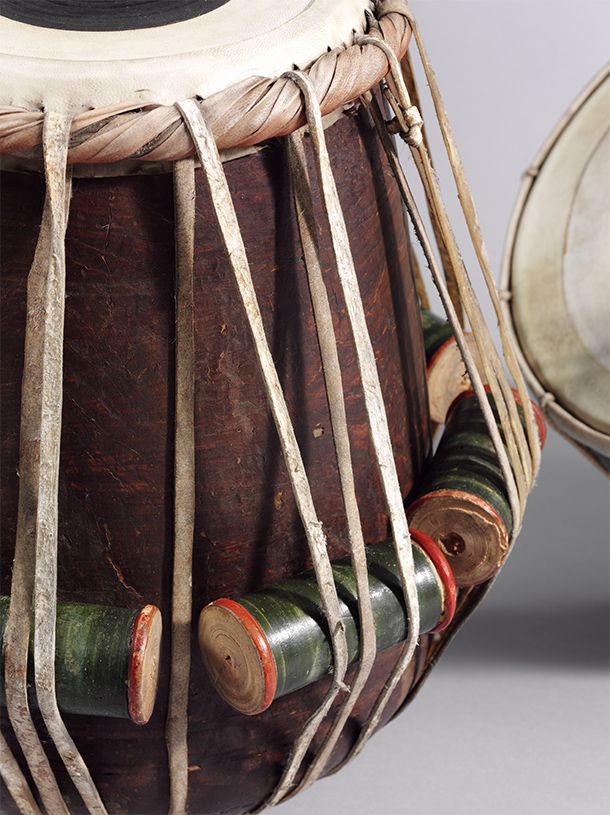Display: Musical Wonders of India
Tabla
On display in South Asia, Room 41, 16 September 2015 - 31 October 2016

Tabla
One tinned copper, the other wood with lacquered wood reels; parchment with siyahi (black resinous compound); leather thongs and cord, North India, 1870-90. Museum no. IS.69-1890 and IS.70-1890.
Tabla, one tinned copper, the other wood with lacquered wood reels; parchment with siyahi (black resinous compound); leather thongs and cord, North India, 1870-90. Museum no. IS.69-1890 and IS.70-1890. © Victoria and Albert Museum, London
The tabla is a prominent percussion instrument in Northern India and the Deccan. It is a set of two drums. The metal drum with the broader head is the bass and is normally played with the left hand. It is called the bahya or bayan.
The taller, treble drum is played with the right hand. It is sometimes called the dahya, dahina or dayan, but it can also simply be called tabla. It is tuned by hammering down upon the wooden reels to create tension.

Dahya, also known as dahina or dayan, height 32cm
Dahya, also known as dahina or dayan, height 32cm © Victoria and Albert Museum, London
The visible parchment face of the tablas is called the maidan, which means an ‘open space’. The maidan is partially covered with a black discs formed of an application of resinous compound of several materials called siyahi (ink). The siyahi increases the range of sounds that the musician can make on the tablas and affects the resonance and pitch of the drum. A thin application of siyahi gives a higher pitch and a thick application cause the drums to have a lower pitch. It is placed centrally on the dahya and off-centre on the bahya. The off-centre application of the siyahi on the bahya gives it extra versatility to its soundscape.

Bahya, also known as bayan, height 25cm
Bahya, also known as bayan, height 25cm © Victoria and Albert Museum, London
The musician can achieve a wide variety of sounds by striking the drums in different ways, including sliding the hand across bahya.
This tabla is in excellent condition considering its early date. The donor, Rajah Sir Sourindro Mohun Tagore, was a highly respected ethnomusicologist who gave collections of Indian musical instruments to museums across the world, including the V&A in 1890.
Watch Bickram Ghosh play and explain the Tabla on the Darbar Festival YouTube channel
Supported by
![]()

Contents
V&A Innovative Leadership Programme

The V&A Innovative Leadership Programme is aimed at managers working in the arts & creative industries looking to develop new skills, insight and opportunity. Applications are now open for the next course.
Apply now